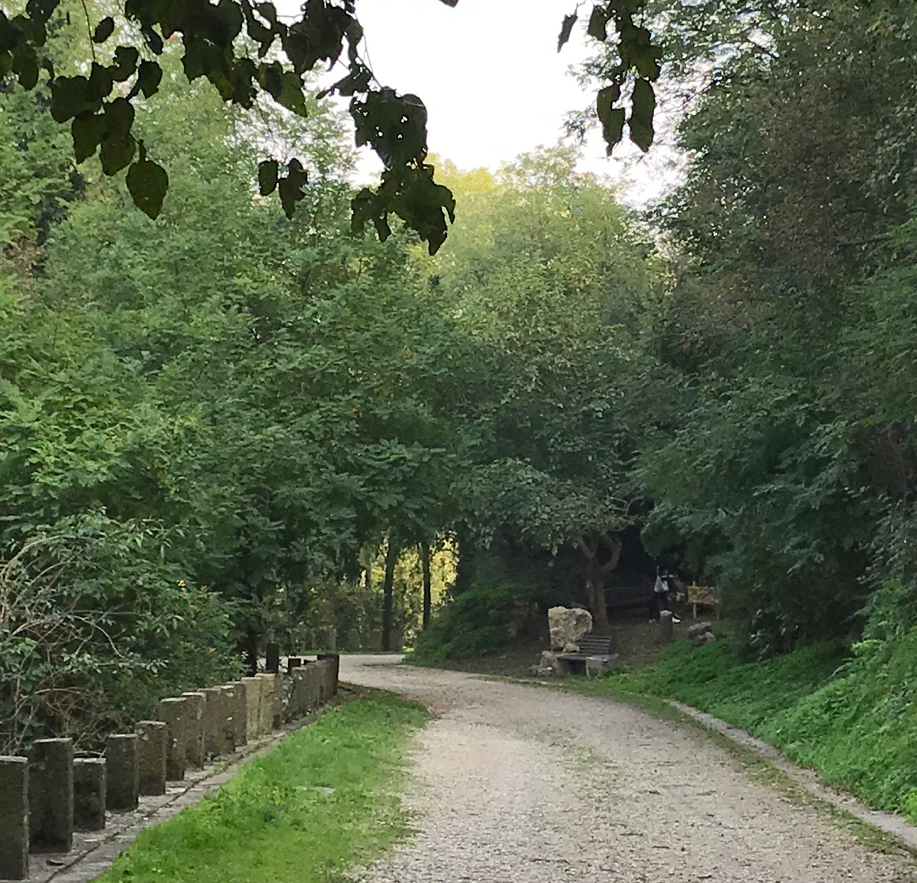How do you express your feelings to your loved one in 2020? Do you sense a change of mood is in the air in this new decade? No more big boxes of chocolates; no more indulging in elaborate candlelit meals in starred restaurants; no more red roses flown in from the other side of the world....
In these enlightened times, we’re all trying to think and behave differently, to be environmentally friendly and to look after our physical and mental well-being, so here’s an idea for something which ticks all those boxes and is still romantic.
You can go for a themed walk. The Viale dell’Amore just outside Montegrotto Terme in the Veneto south of Padua is just one example of a romantic trail you can follow with a partner, sharing lovely views, fresh air and a healthy walk whilst stopping to read inspirational poetry. As their leaflet says,
“La natura non e un posto da visitare. È casa nostra “
(“Nature isn’t a place to visit. It’s our home”)
The walk begins at the (free) car park at the bottom of Monte Alto and gently climbs up a winding strada bianca (unsurfaced track) to Villa Draghi, a beautifully restored small Venetian gothic castle where there are organised events, such as traditional music and dancing, choral singing, talks on local flora and fauna etc, every weekend in summer, run by volunteers. Check the website for any special events for Valentine’s Day. (At the time of writing it hadn’t been decided, but there will certainly be something happening!)

At every turn there is a bench and a plaque with a romantic piece of poetry to read whilst enjoying the view, and luckily there are enough gaps between the trees to make this possible. On a good day they say you can see across the plain to Venice, especially from the top floor of the villa.
The first poem you come across ‘Ho sceso, dandoti il braccio’ is by Eugenio Montale. The first lines translate as:
I went down a million stairs at least, arm in arm with you.
And now that you are not here, I feel emptiness at each step...
Perhaps that particular poem, though lovely, is rather sad, but there are many more famous Italian poets who are represented: Leopardi, Alighieri, Buonarroti, Merini to name a few. It’s appropriate that there’s a poem by Petrarch since he spent his last days in the nearby lovely village named after him, Arquà Petrarca. Amazingly, since he was a contemporary of Chaucer, his house is still there, and can be visited. (It was Petrarch who invented a particular form of sonnet which became very popular, only rivalled by the Shakespearean sonnet which of course came later.)
Probably the most notorious poet is the eccentric Gabriele d’Annunzio, Prince of Montenevoso, who wore an eyepatch and looked rather dashing. He spent much of his time nearby in the castle of San Pelagio, from where he famously set off by plane in the First World War to drop pamphlets over Vienna to prove that he could equally have dropped bombs. (Unsurprisingly this is now a small museum of the air.) His colourful career as a poet, playwright, soldier and politician made him one of the great personalities of his day. His works are characterised by the gratification of the senses whether though the love of women or nature. You can judge for yourself how romantic his poem is, (“Stay with me...”) but in his private life he had a succession of mistresses, all devoted to him, the most notable being Eleonora Duse, the actress, for whom he wrote several plays. The forlorn-looking possessions of his many lovers, including their shoes and gloves, can be seen in the museum.
To add to the atmosphere, look out for flora and fauna. There may be snowdrops, early wild crocuses and primroses. It’s too early for cuckoos, but appropriately the woodland birds will be starting to look for a mate and sing. At intervals there are useful notice boards in several languages which explain the volcanic geology and tell you what wildlife you might see, as well as showing a detailed map so that you can extend your walk. It’s great walking country, and for the less athletic, there’s always the reassurance that the walks, once you reach the starting point, are generally circular, and on the same level, as they go around the extinct volcanic cones. In fact, you could use this idea for inspiration and choose any favourite walk, setting off with a few well-chosen love poems in your pocket.
As you walk slowly along Viale all’Amore you come across couples reading the poems, often aloud to one another. It all seems very romantic, and makes everyone on the pilgrimage smile. I’ve even seen one young man recite a poem on one knee in front of his girlfriend. Maybe it was the background to a proposal. I like to think so. But rest assured, even if the car park is full on this special day, there’s plenty of space to wander away from crowds, and the atmosphere will be perfect for young lovers.
It's worth noting that on Saturday 15th there will be a walk along the avenue while reading love poems organized by Gal Patavino within the initiative "Passaggi Rurali, dai Colli all'Adige" and in collaboration with the Department of Culture of Montegrotto. Joining is free of charge, you can call Alice at +39 3476238422 for more information.
Further information:
How to get there: Take the Terme Euganee exit from the Venice-Bologna motorway. The Viale dell’Amore is on the outskirts of Montegrotto Terme, 2 miles from the station if coming by train.
Air Museum of San Pelagio near Montegrotto, signed from the SS 16.
Use a Padova card (part of a scheme to visit important sites in the area) to visit the house of Petrarch. The leaflet gives opening times.















